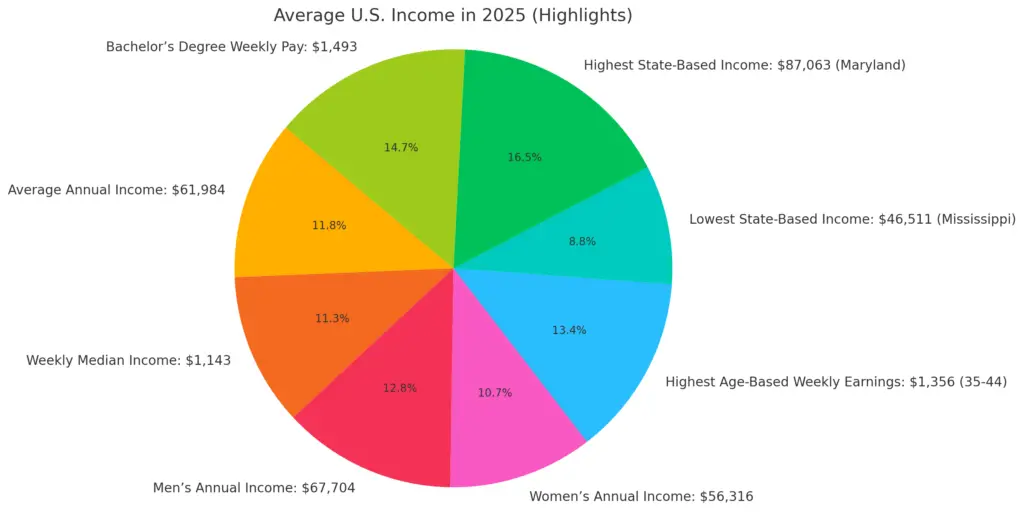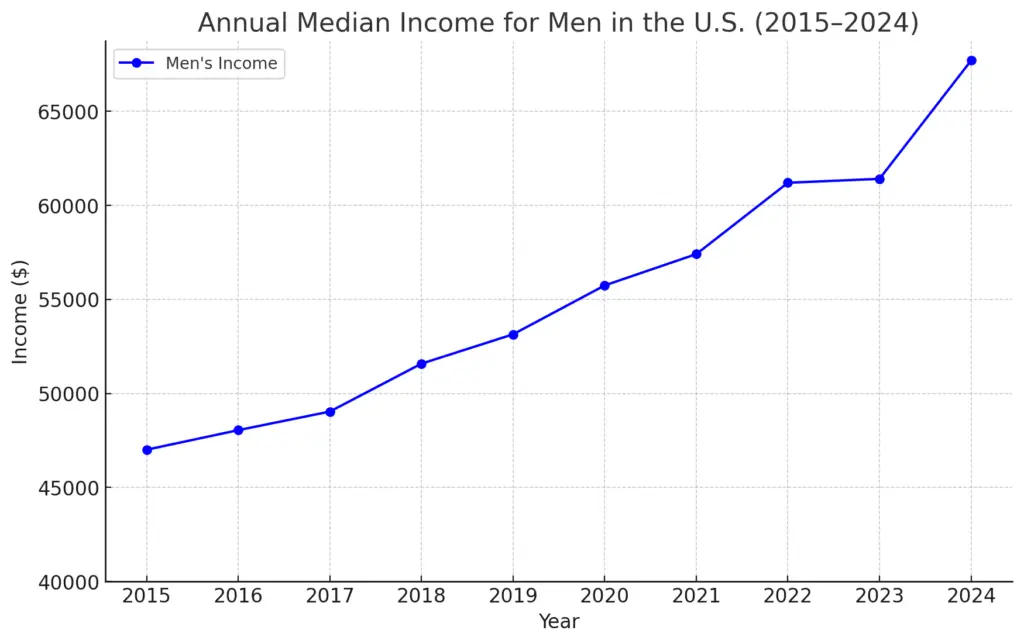As of 2025, the average income in the United States has seen a year-over-year increase of 3.9%. This uptick in earnings reflects a broader trend of rising costs of living across the nation. Currently, the average individual income stands at $61,984, with projections indicating continued growth in the coming years.
In this article, we’ll explore the median income of U.S. adults across various categories, including demographics, educational attainment, and geographical locations.
Key Income Statistics for 2025
Income levels in the U.S. continue to climb, with the average annual salary reaching $61,984 in 2025 — a 4.38% increase from the previous year. Full-time workers are now earning a median weekly wage of $1,143, reflecting consistent growth across various demographics and sectors.
This article provides a detailed analysis of income trends in 2025, highlighting gender pay gaps, racial and educational disparities, and variations by age and state.

Average U.S. Income in 2025 (Highlights)
- 📈 Average Annual Income: The typical U.S. worker earns $61,984 per year, showing stable wage growth.
- 💼 Weekly Median Income: Full-time employees make a median of $1,143 per week.
- 🚹🚺 Gender Pay Gap: Men earn an average of $67,704 annually, while women make $56,316 — a gap of $11,388.
- 🧑🤝🧑 Age-Based Earnings: Workers aged 35 to 44 have the highest median weekly pay at $1,356, followed by those aged 45 to 54 at $1,336.
- 🌍 Income by Race: Asian workers have the highest median weekly earnings at $1,507.
- 🏙️ State-Based Income: Maryland leads with the highest average income at $87,063, while Mississippi reports the lowest at $46,511.
- 🎓 Impact of Education: A bachelor’s degree significantly boosts earnings, with weekly pay averaging $1,493 compared to $899 for high school graduates — a difference of nearly $600 per week.
Breakdown of Average Income in the U.S.
According to data from the U.S. Bureau of Labor Statistics, the median weekly earnings for full-time workers in the second quarter of 2024 were $1,143, marking a 3.9% increase from the prior year.
The average annual salary as of Q2 2024 is $59,436, a modest rise from $59,384 recorded at the end of 2023. It is crucial to note that these figures represent gross earnings before taxes and deductions and may include overtime pay, commissions, and tips.
Historical Average Annual Income in the U.S.
| Year | Average Annual Income |
|---|---|
| 2024 | $61,984 |
| 2023 | $59,384 |
| 2022 | $55,164 |
| 2021 | $52,009 |
| 2020 | $51,305 |
| 2019 | $47,812 |
| 2018 | $46,196 |
| 2017 | $44,827 |
| 2016 | $43,406 |
| 2015 | $42,168 |
| (Source: U.S. Bureau of Labor Statistics) |
Examining Average Household Income in the U.S.
The median household income in the U.S. is approximately $78,171 for 2024. This reflects a decrease of nearly $2,000 compared to the previous year, with 2023 recording a median household income of $80,610—the most substantial increase observed since 2019. Notably, income growth has varied significantly by race, with White and non-Hispanic White households seeing marked gains.
Median Household Income by Race
| Race | Income in 2022 | Income in 2023 |
|---|---|---|
| All Races | $77,500 | $80,610 |
| White | $80,300 | $84,600 |
| White Non-Hispanic | $84,300 | $89,100 |
| Black | $55,000 | $56,500 |
| Asian | $113,100 | $112,800 |
| Hispanic (All Races) | $65,300 | $65,500 |
| (Source: CNBC 1, CNBC 2) |
Average Income by State
Massachusetts leads in average annual salaries at $76,600, followed closely by New York at $74,870. Other states featuring high average earnings include California, Washington, and New Jersey.
States with the Highest Average Salaries
| State | Average Annual Income |
|---|---|
| Massachusetts | $76,600 |
| New York | $74,870 |
| California | $73,220 |
| Washington | $72,350 |
| New Jersey | $70,890 |
Conversely, Mississippi holds the title for the lowest average annual wage at just $45,180.
States with the Lowest Average Salaries
| State | Average Annual Income |
|---|---|
| Mississippi | $45,180 |
| Arkansas | $48,570 |
| West Virginia | $49,170 |
| South Dakota | $49,890 |
| Alabama | $50,620 |
| (Source: Forbes) |
Average U.S. Income by Gender
Earnings in the U.S. continue to show a notable gender gap, driven by differences in industry representation, work experience, and structural wage differences.
Men’s Average Annual Income
The median annual income for men in the U.S. reached an all-time high of $67,704 in 2025.
- From 2023 to 2024, men’s earnings increased from $61,412 to $67,704 — a significant jump of 10.25% ($6,292).
- Over the past decade, men’s earnings have risen by 44% — from $47,008 in 2015 — marking a long-term trend of rising wages despite periods of economic slowdown.
Annual Median Income for Men (2015–2024):

| Year | Annual Median Income of Men ($) |
|---|---|
| 2024 | 67,704 |
| 2023 | 61,412 |
| 2022 | 61,204 |
| 2021 | 57,408 |
| 2020 | 55,744 |
| 2019 | 53,144 |
| 2018 | 51,584 |
| 2017 | 49,036 |
| 2016 | 48,048 |
| 2015 | 47,008 |
Source: U.S. Bureau of Labor Statistics
Women’s Average Annual Income
Women’s median annual income in the U.S. is $56,316, which is $11,388 less than men’s earnings.
- Women earn 83 cents for every dollar men make.
- On a weekly basis, men earn $1,302 while women make $1,083, reflecting a gap of $219 per week.
Although the gender pay gap has narrowed over time, women still earn approximately 17% less than men on average.
Annual Median Income for Women (2015–2024):
| Year | Annual Median Income of Women ($) |
|---|---|
| 2024 | 56,316 |
| 2023 | 51,931 |
| 2022 | 50,700 |
| 2021 | 48,308 |
| 2020 | 46,488 |
| 2019 | 43,784 |
| 2018 | 41,340 |
| 2017 | 40,040 |
| 2016 | 39,468 |
| 2015 | 37,908 |
Source: U.S. Bureau of Labor Statistics
U.S. Income by Age
Income levels tend to rise with age and work experience. Workers aged 35 to 44 earn the highest wages, while younger workers (16 to 24 years old) have the lowest earnings.
Median Weekly Income by Age (2025):
| Age Group | Total ($) | Men ($) | Women ($) |
|---|---|---|---|
| 16 years and over | 1,192 | 1,302 | 1,083 |
| 16 to 24 years | 766 | 796 | 721 |
| 25 to 34 years | 1,136 | 1,187 | 1,062 |
| 35 to 44 years | 1,356 | 1,488 | 1,205 |
| 45 to 54 years | 1,336 | 1,468 | 1,193 |
| 55 to 64 years | 1,268 | 1,442 | 1,097 |
| 65 years and over | 1,159 | 1,313 | 1,055 |
Source: U.S. Bureau of Labor Statistics
U.S. Income by Race
Significant differences in income remain across racial and ethnic groups in the U.S.:
- Asian workers earn the highest median weekly income at $1,507.
- White workers earn $1,207 per week.
- Black workers earn $1,040 per week.
- Hispanic workers earn the lowest, with median weekly earnings of $920.
These differences reflect variations in education, job opportunities, and industry representation.
U.S. Income by Family Size
Larger families generally have higher total incomes, reflecting the combined earnings of multiple working family members.
Median Income by Family Size (2025):
| Family Size | Annual Median Income ($) |
|---|---|
| 2 people | 86,430 |
| 3 people | 107,100 |
| 4 people | 125,700 |
| 5 people | 115,400 |
| 6 people | 118,000 |
| 7+ people | 99,600 |
Source: U.S. Census Bureau
U.S. Income by Education
Higher education remains a key driver of higher income. Workers with advanced degrees tend to earn significantly more than those with only a high school diploma.
Median Weekly Income by Education (2025):
| Education Level | Median Weekly Income ($) |
|---|---|
| Less than High School Diploma | 708 |
| High School Diploma | 899 |
| Some College, No Degree | 992 |
| Associate’s Degree | 1,058 |
| Bachelor’s Degree | 1,493 |
| Master’s Degree | 1,737 |
| Professional Degree | 2,206 |
| Doctoral Degree | 2,109 |
Source: U.S. Bureau of Labor Statistics
Key Takeaways
✅ The average annual income in the U.S. is $61,984 — a 4.38% increase from 2023.
✅ Men earn $67,704 annually, while women earn $56,316 — a gender pay gap of $11,388.
✅ Asian workers have the highest weekly earnings at $1,507, while Hispanic workers have the lowest at $920.
✅ Education plays a major role in earnings — workers with a professional degree make $2,206 weekly, compared to $708 for those without a high school diploma.
✅ Maryland leads with the highest average income at $87,063, while Mississippi has the lowest at $46,511.
You May Like these article:

